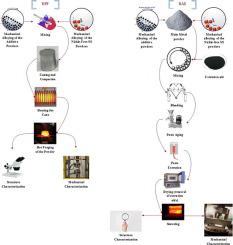Advanced Powder Technology ( IF 4.2 ) Pub Date : 2020-07-07 , DOI: 10.1016/j.apt.2020.06.025 L. Heidari , A. Tangestani , M.J. Hadianfard , D. Vashaee , L. Tayebi

|
An ASTM F2581 nanostructured stainless steel was fabricated by two different powder metallurgy routes; Hot Powder Forging (HPF) and Binder Assisted Extrusion (BAE) methods. Their structure and mechanical properties were investigated and compared. In both fabrication methods, the alloy powder was made by using main alloying elements through mechanical alloying, along with the addition of a sintering aid. In the BAE method, a paste was prepared by mixing alloy powders with polymer followed by cold extrusion, polymer removal, and sintering. In the HPF method, the alloy powders were hot forged under high pressure. The structure and the size of the austenite crystallite of the samples were investigated by scanning electron microscopy (SEM), FE-SEM, x-ray diffraction (XRD) and transmission electron microscopy (TEM). It was determined that the samples prepared by the HPF method are generally denser than those made via BAE. The porosities are smaller and almost uniform in size and morphology in the HPF method. Furthermore, microhardness and tensile tests were performed on the samples. The results show that the ductility of BAE samples is higher than the HPF samples. The fracture surface of the BAE sample has deeper dimples, indicating higher ductility for BAE samples. On the other hand, both the hardness and strength of HPF samples are higher than those of the BAE samples. The results show that both methods produced specimens with considerably higher strength and hardness than conventional 316L stainless steel.
中文翻译:

制备方法对纳米结构无镍不锈钢组织和性能的影响
通过两种不同的粉末冶金路线制造了一种ASTM F2581纳米结构不锈钢。热粉末锻造(HPF)和粘合剂辅助挤压(BAE)方法。研究和比较了它们的结构和力学性能。在这两种制造方法中,合金粉末都是通过机械合金化使用主要合金元素并添加烧结助剂制成的。在BAE方法中,通过将合金粉末与聚合物混合,然后冷挤压,去除聚合物和烧结来制备糊剂。在HPF方法中,合金粉末在高压下热锻。通过扫描电子显微镜(SEM),FE-SEM,x射线衍射(XRD)和透射电子显微镜(TEM)研究了样品的奥氏体微晶的结构和尺寸。已经确定,通过HPF方法制备的样品通常比通过BAE制备的样品致密。在HPF方法中,孔隙较小并且尺寸和形态几乎均匀。此外,对样品进行了显微硬度和拉伸试验。结果表明,BAE样品的延展性高于HPF样品。BAE样品的断裂表面具有更深的凹坑,表明BAE样品具有更高的延展性。另一方面,HPF样品的硬度和强度均高于BAE样品。结果表明,两种方法所生产的试样均具有比常规316L不锈钢更高的强度和硬度。在HPF方法中,孔隙较小,尺寸和形貌几乎一致。此外,对样品进行了显微硬度和拉伸试验。结果表明,BAE样品的延展性高于HPF样品。BAE样品的断裂表面具有更深的凹坑,表明BAE样品具有更高的延展性。另一方面,HPF样品的硬度和强度均高于BAE样品。结果表明,两种方法所生产的试样均具有比常规316L不锈钢更高的强度和硬度。在HPF方法中,孔隙较小,尺寸和形貌几乎一致。此外,对样品进行了显微硬度和拉伸试验。结果表明,BAE样品的延展性高于HPF样品。BAE样品的断裂表面具有更深的凹坑,表明BAE样品具有更高的延展性。另一方面,HPF样品的硬度和强度均高于BAE样品。结果表明,两种方法所生产的试样均具有比常规316L不锈钢更高的强度和硬度。表明BAE样品具有更高的延展性。另一方面,HPF样品的硬度和强度均高于BAE样品。结果表明,两种方法所生产的试样均具有比常规316L不锈钢更高的强度和硬度。表明BAE样品具有更高的延展性。另一方面,HPF样品的硬度和强度均高于BAE样品。结果表明,两种方法所生产的试样均具有比常规316L不锈钢更高的强度和硬度。











































 京公网安备 11010802027423号
京公网安备 11010802027423号